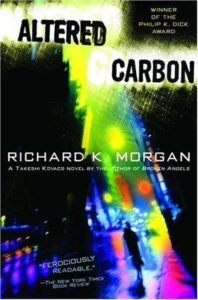 Richard Morgan’s Altered Carbon features Kovacs, a hard-boiled cop in the 25th century San Francisco Bay Area. He’s been hired to find the murderer of his employer. The victim had a backup consciousness stored in a vault, so he’s been “resleeved,” or in other words, re-incarnated into a new body and he’s fine. Everyone does it.
Richard Morgan’s Altered Carbon features Kovacs, a hard-boiled cop in the 25th century San Francisco Bay Area. He’s been hired to find the murderer of his employer. The victim had a backup consciousness stored in a vault, so he’s been “resleeved,” or in other words, re-incarnated into a new body and he’s fine. Everyone does it.
Even reincarnated though, the employer is angry about having been murdered. The police insist it was suicide, but he’s sure it wasn’t and wants Kovacs to find the bad guy. Why? We don’t know. Maybe because murder is just “wrong,” even if it doesn’t really end a life and has no important consequences? Also, it is unclear where the society gets all the fresh bodies needed for all the re-incarnations.
Kovacs is a Chandleresque tough who can beat up three guys in an alley and can take a beating himself when required. He speaks in smart-aleck remarks and has a tedious verbal love-hate relationship with the head Bay Area cop who wants him ‘off the case’ (though the case is closed).
So how is San Francisco in the 25th century? The pinnacle of human achievement in the sciences and the arts? The perfection of human nature, with universal education, empathy, prosperity and goodwill for all? Of course not. Nobody wants that.
Kovacs finds himself hanging out in dimly lit strip clubs with drug dealers, prostitutes and weapons merchants. He spends most of his time whizzing around in air or ground taxis, getting laid and getting into fights.
The fights often involve detailed, prolonged, and bloody torture, with plenty of fluids and detached body parts. Not much difference from the sex scenes, actually. It’s hard to imagine what kind of reader still finds such descriptions interesting. Thirty years ago, even twenty, that might have been titillating or shocking. Today, when everything you can think of has been done to death and filmed and posted besides, I would not have thought it was possible to entertain a reader with clinical sex and graphic violence. But I guess the appetite is insatiable.
I found the unrelenting sex and violence so boring and repetitive it did not rise to the level of being offensive. What I did find offensive was the author’s apparent contempt for women, expressed through the narrator. Once, after Kovacs has been killed (yet again), he is re-incarnated into a woman’s body!
“I sat on the wooden floor and looked down on myself. They’d sleeved me in a woman’s body, young, no more than twenty years old, with copper sheened skin and heavy bell of black hair… I was clothed in a rough khaki shirt several sizes too big for my sleeve and nothing else. Beneath it, my breasts felt swollen and tender…
…In general, and maybe because of this, female pain thresholds ran higher than male, but the menstrual cycle dragged them own to an all-time low once a month.
…I lunged for his eyes with the nails of my free arm…but I had no control and I missed. Two of my nails drew blood on his cheek. He flinched and jumped back. “Bitch cunt,” he said, lifting a hand to the claw mark…” (pp 116-117).
That passage also illustrates the level of diction and craft in this very long novel (It’s densely typeset at nearly 400 6 x 9 pages). Characters speak only in declaratives, which is handy for narrative exposition. Most of the book is made up of characters telling each other the plot points. Even so, you’ll need a scorecard to keep track of the cast of hundreds who come and go.
Raymond Chandler did that (e.g., Farewell, My Lovely, The Big Sleep), and having a large cast is a genre style successfully emulated by Thomas Pynchon (Inherent Vice) and Haruki Murakami (Hard Boiled Wonderland and the End of the World), but Morgan substitutes cliché for wit, so the old trick, ‘a man with a gun appeared,’ falls flat.
Narrator Kovacs suffers the fate of anybody you spend too much time with, becoming boring. Nobody is sustainably interesting for a hundred thousand words. Almost nobody. Exceptions can be found.
Kovacs has virtually no psychological interior so he is as interesting as the drab clothes he wears. He does, from time to time, muse on whether his his essential self is lost each time he is reincarnated, but he’s no philosopher and doesn’t have a clue what personality or consciousness might be and cannot answer his own questions.
As a result, the book has no chance to qualify as psi-fi because there is no “psi” in it. There’s hardly much “sci” either. Except for the reincarnation gimmick and a few technologies like flying taxis, this story could have been set in the 1940’s. It’s an action-adventure, tough-guy cop romp that’s very well-worn. It can stand as a negative example: Not psi-fi, barely sci-fi, but it is fiction.
Morgan, Richard K. (2002). Altered Carbon. New York: Del Rey, 375 pp.